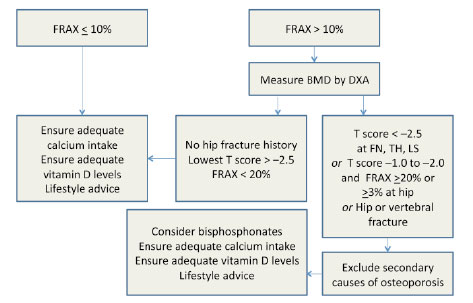14 Use either FRAX 8 without a bone mineral density BMD value if a dual-energy X-ray absorptiometry DXA scan has not previously been undertaken or QFracture 9 within their allowed age ranges to estimate 10-year predicted absolute fracture risk when assessing risk of fracture. Testing your bone density -- how strong your bones are -- is the only way to know for sure if you have osteoporosis.
 Diagnosis And Management Of Osteoporosis American Family Physician
Diagnosis And Management Of Osteoporosis American Family Physician
Within 10 years of menopause 2-3 years post initial DXA scan.

Dexa scan guidelines. Risk factors include dementia poor health recent falls. Adequate calcium consumption using dietary supplements if dietary sources are not adequate Adequate vitamin D consumption 400 to 800. Dont use dual-energy X-ray absorptiometry DEXA screening for osteoporosis in women under age 65 or men under 70 with no risk factors.
Recommendations for osteoporosis screening with DEXA scan. TABLE OF CONTENTS Chapter Page 1 OVERVIEW OF DXA. Following major alteration in treatment type.
Dual-Energy X-Ray Absorptiometry DEXA tests scan a womans bone density and quantify her risk. The test result is based on statistical standard deviations that compare an individuals results to healthy young females average bone density. While several bone measurement tests similarly predict risk of fractures DXA provides measurement of bone mineral density BMD and most treatment guidelines use central DXA to define osteoporosis and the treatment threshold to prevent osteoporotic fractures.
All other groups 4-5 years post initial scan. This provides a new baseline measurement eg HRT to bisphosphonates but not from one HRT to another. 1-1 11 Overview of Dual Energy X-Ray Absorptiometry.
Postmenopausal women under 65 years withat least one of the following. The most common way to screen for weak bones is to assess bone density. Recommendations are to screen for risk factors of osteoporosis and to perform BMD measurement in women with such risks.
The US Preventive Services Task Force recommends that all women over age 65 years have a bone density test. If the result is -25 or lower ie more negative. Women should be counseled about the following preventive measures.
All women aged 65 years and older No Every 210 years depending on initial T-score No upper age limit. The following recommendations are based on limited or inconsistent scientific evidence Level B. In women 65 years of age and older at baseline screening with a T-score of -150 to -199 at any site and with no.
Perimenopausal women 1-2 years post menopause. In addition they recommend a test for women who are under age 65 but have clinical risk factors that predict a 93 or higher 10-year risk of having a major osteoporotic fracture. Screening Recommendations and Tests.
The most widely used is a scan called dual energy X-ray absorptiometry DXA or. The new guidelines recommend that clinicians assess risk factors for osteoporosis in older men and that clinicians obtain a dual-energy x-ray absorptiometry DXA scan for men at increased risk for osteoporosis who are candidates for drug therapy. If initial bone density testing shows you have a T-score of -200 to -249 at any site or if you take medications.
The In ternational Society for Clinical Densitometry ISCD recommends screening men without risk factors for osteoporosis at age 70 and screening higher-risk men earlier.
